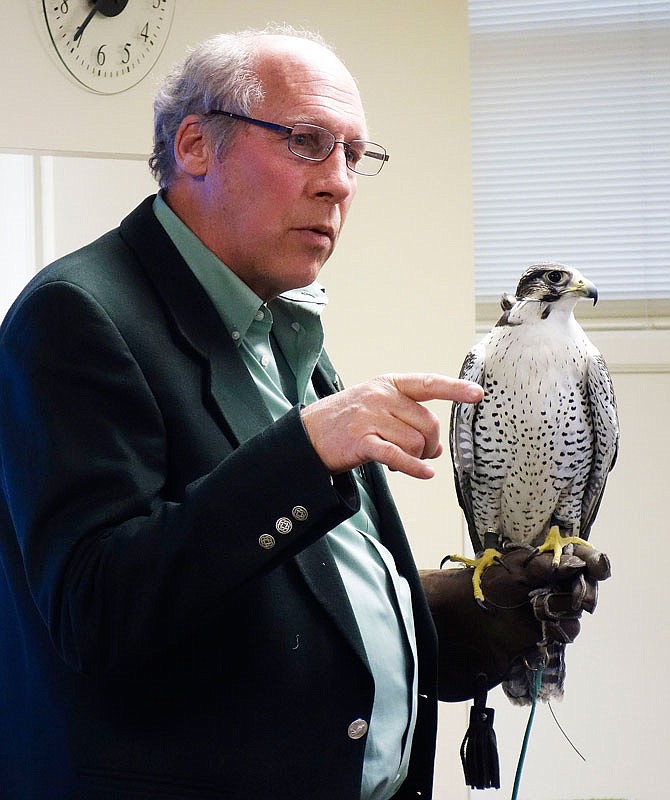Falconer Stephen Heying often says a prayer to a falcon, one he said describes why he's flown the predatory birds since he was a 13-year-old boy in 1969.
"Imagine my life with wings," he said.
He and his falcon Big Bird - sometimes called Moose - are a pair. She gives him a Chance to fly.
"I'm stuck on the ground, Heying said. "But we're a team. I build the teamwork. I become the bird."
Heying and fellow falconers Jeff Peters, both from Columbia, and Cody Kambell, of Holts Summit, brought their birds to the Callaway County Public Library on Saturday to educate and promote this ancient hunting sport.
Heying said Egyptions had a god named Horus, a falcon-headed man wearing a red and white crown as a symbol of kingship over all of Egypt. There is no proof Egyptions used falcons for hunting; evidence of that comes from Mesopotamia where earliest accounts dated back to about 2000 B.C. More evidence is found in the norther Aitai in western Mongolia. Europeans discovered falconry probably around the year 400 A.D., perhaps spreading via the Silk Road and the Crusades. King Frederick II of Hohenstaufen (1194-1250) wrote a book in Latin that became a wellspring of knowledge, and the sport continued as a way to hunt, entertain and court the opposite sex.
Dogs bred to hunt with birds of prey also developed, from Saluki to Visla to pointers. Language also emerged along with the sport.
"Have you heard 'out for a lark?'" Heying asked the audience. "Or 'beating around the bush?'"
Even the golf term "caddy" came from the word describing the person who carries the hawks for the hunter.
Kambell brought his little merlin, a smaller species often refered to as "ladies' hawks." Peter's 4-year-old bird Cassie was the largest on hand at 54 ounces, while Big Bird weighed 44 ounces.
All three wore comfortable hoods that kept them (mostly) quiet, but each proved capable of a bit of squawking and wing flapping.
"The hood fools them into thinking it's dark," Heying said, adding his bird's leather hood cost about $100.
A fun fact: Falcons are colorblind but they do have independent sight. Their eyes can focus separately. When their eyes work together, it gives them great depth perception. And the reason their sight is so keen is they see in far more pixels than humans do.
"It's a higher resolution," Heying said.
When birds like falcons walk like pigeons and chickens, their noses poking in and out, that means they are focusing their eyes.
Falcons have black markings under their eyes - like football players - to cut glare. That helps them see better, too.
Their little nostrils curve the air like a spiral of water going down a drain. That means when they're power diving for prey, they don't blow up from the wind rushing in.
GPS and other technologies have shown falcons diving at 278 miles per hour. They might even be proven faster, he said, as technology improves.
Peters has been a falconer since the 1950s.
"I had the third falconry license ever issued in the state of Missouri," he said. "I got it around 1959."
Heying said Moose doesn't like to be cuddled.
"She's a partner; not a pet," he added. "They don't like to be messed with. They're solitary, independent thinkers."

